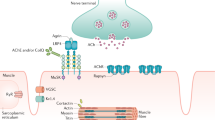Summary
The sera of 65 patients with myasthenia gravis (MG) were analysed for antibodies against the nicotinic acetylcholine receptor (ACh-R) using an immunoprecipitation assay (125I-α-bungarotoxin bound to human ACh-R as antigen). In 91% of MG sera elevated antibody titers were found ranging up to 500 times reference values. A control group of 77 patients showing various autoimmunological phenomena had ACh-R antibody concentrations within the reference range. The demonstration of antibodies against ACh-R provides a sensitive and highly specific tool for the diagnosis of MG. In addition, the test is helpful in following patients under treatment with immunosuppressive drugs or plasmapheresis. Antibodies against striated, smooth, or heart muscle (indirect immunofluorescence test) are much less sensitive and nonspecific for the diagnosis of MG.
Zusammenfassung
Bei 65 Patienten mit Myasthenia gravis (MG) wurden Antikörper gegen Acetylcholin-Receptoren (ACh-R) in der IgG-Fraktion des Patienten-Serums bestimmt (Immunpräzipitations-Assay mit125Jod-α-Bungarotoxin und menschlichem ACh-R als Antigen). Bei 91% der Patienten zeigte sich eine erhöhte Antikörper-Konzentration bis zum 500fachen des oberen Referenzbereichs. Eine Kontrollgruppe von 77 Patienten mit anderen gesicherten Autoimmunerkrankungen oder positiven Antikörpern gegen Muskulatur wies in keinem Fall erhöhte ACh-R-Antikörper-Konzentrationen auf. Damit ist der in-vitro Nachweis von ACh-R-Antikörpern ein empfindlicher und hochspezifischer Test für die Diagnostik der MG. Der Test eignet sich ebenfalls für die Verlaufskontrolle unter Therapie mit Immunsuppressiva oder Plasmapherese. Immunfluoreszenz-Untersuchung auf Antikörper gegen Muskelgewebe ist für die MG-Diagnostik weniger empfindlich und nicht spezifisch.
Similar content being viewed by others
Literatur
Aharonov, A., Abramsky, O., Tarrab-Hazdai, R., Fuchs, S.: Humoral antibodies to acetylcholine receptor in patients with myasthenia gravis. Lancet2, 340–342 (1975)
Almon, R.R., Andrew, C.G., Appel, S.H.: Serum globulin in myasthenia gravis: inhibition of alpha-bungarotoxin binding to acetylcholine receptors. Science186, 55–57 (1974)
Bender, A.N., Ringel, S.P., Engel, W.K., Daniels, M.P., Vogel, Z.: Myasthenia gravis: a serum factor blocking acetylcholine receptors of the human neuromuscular junction. Lancet1, 607–609 (1975)
Changeux, J.P., Benedetti, L., Bourgeois, J.P., Brisson, A., Cartaud, J., Devaud, P., Grünhagen, H., Moreau, M., Popot, J.L., Sobel, A., Weber, M.: Some structural properties of the cholinergic receptor protein in its membrane environment relevant to its function as a pharmacological receptor. In: The Synapse, Cold Spring Harbor Symp. Quant. Biol. pp. 211–230 1976
de Crousaz, G., Fulpius, B., Monnier, V., Regli, F.: Dosage des anticorps dirigés contre le récepteur nicotinique de l'acétylcholine: corrélations clinicoimmunologiques chez 30 myasthéniques. Schweiz. Med. Wochenschr.108, 602–607 (1978)
Drachman, D.B.: Myasthenia gravis, N. Engl. J. Med.298, 136–142, 186–192 (1978)
Engel, A.G., Lindstrom, J.M., Lambert, E.H., Lennon, V.A.: Ultrastructural localization of the acetylcholine receptor in myasthenia gravis and in its experimental autoimmune model. Neurology (Minneap.)27, 307–315 (1977a)
Engel, A.G., Lambert, E.H., Howard, F.M.: Immune complexes (IgG and C3) at the motor endplate in myasthenia gravis: ultrastructural and light microscopic localization and electrophysiologic correlations. Mayo Clin. Proc.52, 267–280 (1977b)
Fambrough, D.M., Drachman, D.B., Satyamurti, S.: Neuromuscular junction in myasthenia gravis: decreased acetylcholine receptors. Science182, 293–295 (1973)
Greenwood, F.C., Hunter, W.M., Glover, J.S.: The preparation of131J-labelled human growth hormone of high specific radioactivity. Biochem. J.89, 114–123 (1963)
Kalies, I., Kalden, J.R., Heinz, F.: Antibodies to acetylcholine receptors in myasthenia gravis patients and controls. Abstract 34. IV th Intern. Congr. on Neuromuscular Diseases, Montreal, 1978
Kao, I., Drachman, D.B.: Myasthenic immunglobulin accelerates acetylcholine receptor degradation. Science196, 527–529 (1977)
Klett, R.P. Fulpius, B.W., Cooper, D., Smith, M., Reich, E., Possani, L.D.: The acetylcholine receptor. I. Purification and characterization of a macromolecule isolated from Electrophorus electricus. J. Biol. Chem.248, 6841–6853 (1973)
Lefvert, A.K., Bergström, K. Matell, G., Osterman, P.O., Pirskanen, R.: Determination of acetylcholine receptor antibody in myasthenia gravis: Clinical usefulness and pathogenic implications. J. Neurol. Neurosurg. Psychiatry41, 394–403 (1978)
Lindstrom, J.M., Seybold, M.E., Lennon, V.A., Whittingham, S., Duane, D.D.: Antibody to acetylcholine receptor in myasthenia gravis: prevalence, clinical correlates, and diagnostic value. Neurology (Minneap.)26, 1054–1059 (1976)
Lindstrom, J.: An assay for antibodies to human acetylcholine receptor in serum from patients with myasthenia gravis. Clin. Immunol. Immunopathol7, 36–43 (1977)
Mittag, T., Kornfeld, P., Tormay, A., Woo, C.: Detection of anti-acetylcholine receptor factors in serum and thymus from patients with myasthenia gravis, N. Engl. J. Med.294, 691–694 (1976)
Monnier, V.M., Fulpius, B.W.: A radioimmunoassay for the quantitative evaluation of antihuman acetylcholine receptor antibodies in myasthenia gravis. Clin. Exp. Immunol.29, 16–22 (1977)
Nairn, R.C.: Fluorescent protein tracing. Edinburgh, London: Livingstone 1969
Newsom-Davis, J., Pinching, A.J., Vincent, A., Wilson, S.G.: Function of circulating antibody to acetylcholine receptor in myasthenia gravis: investigation by plasma exchange. Neurology (Minneap.)28, 266–272 (1978)
Pestronk, A., Drachman, D.B., Toyka, K.V. (unveröffentl.)
Schumm, F., Stöhr, M.: Myasthene Syndrome unter Penicillamin-Therapie. Klin. Wochenschr.56, 139–144 (1978)
Toyka, K.V., Drachman, D.B., Pestronk, A., Kao, I.: Myasthenia gravis: passive transfer from man to mouse. Science190, 397–399 (1975)
Toyka, K.V., Drachman, D.B., Griffin, D.E., Pestronk, A., Winkelstein, J.A., Fischbeck, K.H., Kao, I.: Myasthenia gravis: study of humoral immune mechanism by passive transfer to mice. N. Engl. J. Med.196, 125–131 (1977)
Vincent, A., Newsom-Davis, J., Cull-Candy, S., Trautmann, A., Miledi, R., Molenaar, P.C.: Congenital Myasthenia gravis. Abstract 184. IVth Internat. Congress on Neuromuscular Diseases, Montreal, 1978
Wick, G., Baudner, S., Herzog.: Immunfluoreszenz. Marburg/Lahn: Medizinische Verlagsgesellschaft 1976
Author information
Authors and Affiliations
Additional information
Herrn Prof. Dr. A. Struppler zum 60. Geburtstag gewidmet
Rights and permissions
About this article
Cite this article
Toyka, K.V., Becker, T., Fateh-Moghadam, A. et al. Die Bedeutung der Bestimmung von Antikörpern gegen Acetylcholinreceptoren in der Diagnostik der Myasthenia gravis. Klin Wochenschr 57, 937–942 (1979). https://doi.org/10.1007/BF01478550
Received:
Accepted:
Issue Date:
DOI: https://doi.org/10.1007/BF01478550
Key words
- Myasthenia gravis
- Acetylcholine-receptor
- Acetylcholine-receptor antibodies
- Autoimmune disease
- Plasmapheresis




